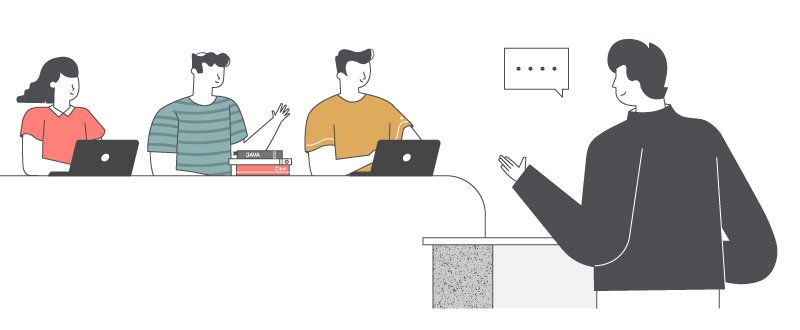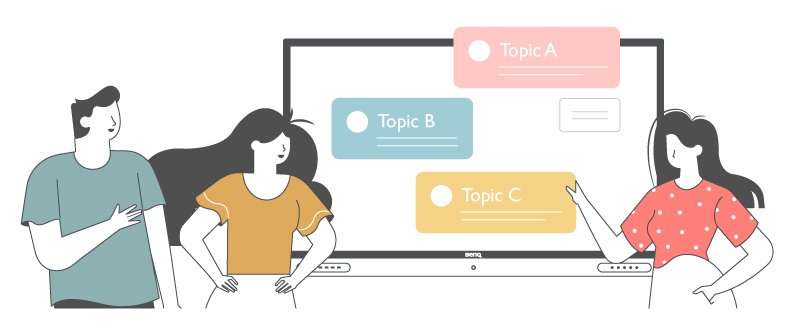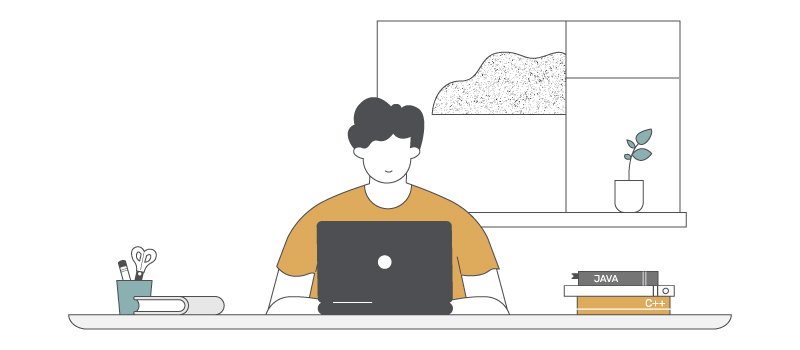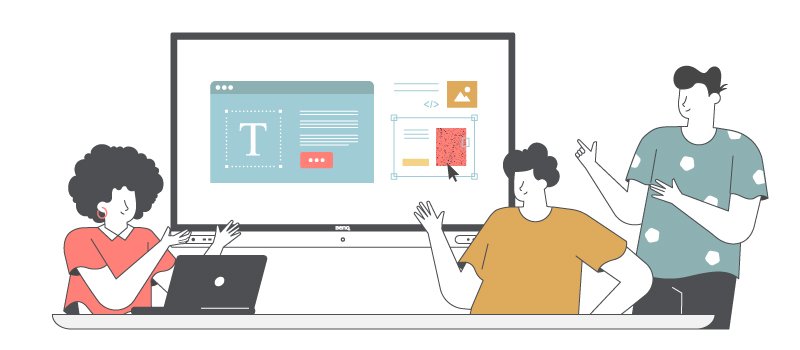Active Learning 101
- BenQ
- 2021-01-25
How often have you encountered the term "active learning"? It's been used enough times in publications that its meaning usually gets confused with other similar modes of learning such as "flipped classrooms" and "blended learning". How are these pedagogies different? What are the advantages of each mode?
If you're from the academe or are part of an educational institution looking to prepare your graduates for today’s workplace demands, it's crucial to identify which approach is which. Doing so helps you asses if your current pedagogy and curriculum are adequate for transferring 21st century skills.
Below, we briefly discuss and differentiate each of the prevalent learning modes used in schools.
Jump to the term
Passive learning vs. Active learning

Passive learning: Teacher holds a lecture while students listen

Active learning: Students hold a group debate about the topic
Many students are perhaps most familiar with passive learning, a type of teaching method where a lecturer discusses topics in class while they follow the session by listening and notetaking. Students retain domain knowledge by reading the provided course material, reviewing their notes, and memorizing key points. Their knowledge is often tested through periodic standardized exams. This type of pedagogy offers minimal opportunities for close mentoring and feedback collection since often, this style is applied to large classes where the ratio between students and teacher is disproportionately skewed.
Active learning is the opposite. In this approach, students play a more hands-on role. Instead of the teacher acting as a lecturer, they become facilitators who guide students as they put the concepts they learned into practice. During class, teachers would continuously engage students, asking them questions and giving them activities that would stimulate thinking.1,2 Students are encouraged to come up with ideas on their own. This way, instead of just memorizing the items they need to pass a written exam, they actually get to explore the concepts being discussed and understand the logical connections behind them.3 This allows them to retain the information for a much longer time and also build their 21st century skillset through activities like data analysis, debating, and dramatization.
This mode of learning, once applied regularly also becomes an essential 21st century skill sought out by employers.4 Active learning, in this context, turns into a habit where students continuously seek ways to gain more domain knowledge by studying new concepts and putting them into practice.
Synchronous learning vs Asynchronous learning
These two learning modes are more straightforward. Synchronous learning requires both students and teachers to be present in class at the same time. This doesn’t necessarily mean they need to be physically in the same classroom. Teachers and students can also hold synchronous learning sessions remotely via the internet. The advantage of synchronous learning, especially in active learning setups, is how teachers can automatically gauge their students’ comprehension through activities and then adjust the pace and level of the discussion accordingly. Students can also take advantage of this setup to immediately ask for assessment and clarifications.
The asynchronous learning mode may not offer the same immediacy, but it also has its advantages. This type of setup works better for students who may not be able to commit to a regular schedule and would rather opt for self-paced learning. The school provides them with materials and tests that they can freely study and take within an agreed time frame. Assessments and feedback collection are done periodically either through scheduled face-to-face consultations or through correspondence.
Blended learning vs. the Flipped classroom model
Blended learning is an educational approach that combines traditional, physical modes of face-to-face teaching with the use of online and digital media. Teachers and students still tackle lessons in the classroom, but at the same time, they make use of online educational tools, portals, and materials like articles, videos, games, and the like.5


Flipped classroom: Students study the course materials on their own time and synthesize their learnings during class via active learning activities
The flipped classroom model shares similarities with blended learning as it may also use online and digital media. But as its name implies, the flipped classroom model is unique in the way it flips how lessons are delivered. Normally, in a traditional classroom model, teachers explain the lesson materials during class while students apply the information to their homework. In a flipped classroom, students are required to study the learning materials at home before showing up to class to process the ideas they’ve picked up with the guidance of a teacher. Students get to demonstrate how much they’ve learned through active learning activities such as presentations and peer critiques.
In-person learning vs. Online learning
Another straightforward term is in-person learning. In this setup, students and their teacher or fellow students hold physical face-to-face learning sessions in the same location. These may be in the form of lectures, one-on-one tutoring sessions, or informal gatherings used to discuss the details of a group project.
For cases when teaching cannot be done in person—whether due to geographical constraints or emergencies such as natural disasters or pandemics—schools can opt to go the online learning route. This web-based model, also referred to as remote learning, takes advantage of technologies such as video conferencing and remote whiteboarding as a means for live instruction.6
In passive online learning setups, students normally access and study learning modules on the school’s online portal and then perform graded tests right after. For more active learning sessions, students can explore their course material and output during the live sessions with a teacher and their peers and then submit all their other requirements via email or through an official school portal to be graded at a later time.
Distance learning vs. Hybrid learning
Hybrid learning combines in-person and online learning through video conferencing
Although it has overlaps with online learning, distance learning is actually much broader in scope and dates back much further. Distance learning is any mode of learning where the student and the instructor are not physically present in the same place during learning sessions. This can be rolled out through correspondence, educational television, and, most recently, video conferencing.
Hybrid learning, on the other hand, is an educational approach that has both an in-person and online learning component. Half of the students are required to be physically present in the classroom with a teacher while the rest of the class joins sessions from home via video conferencing. The supposed advantage of this setup is how it allows teachers to extend their classrooms to specific students and guest lecturers who are located elsewhere.
But based on early accounts from educators forced to adjust to this setup during the pandemic, hybrid learning comes with challenges.7 Some teachers claimed that having two sets of students made it hard for them to prioritize which ones to cater to. There were instances where remote students got more attention than their in-person peers. Another challenge, which is also common for online learning, is the lack of available technology. Not every school is equipped with the appropriate hardware and software tools designed to implement these learning setups.
Adopting active learning modes will not always be a smooth transition, but as long as schools have a clear idea of what learning modes they want to pattern their current pedagogies and curricula to, it will be easier for them to select and invest in the types of technology and training they need in order to produce capable graduates with the necessary 21st century skills.
For more details on the kinds of technology schools can use for active learning setups, you can download our handbook, Active Learning in the 21st Century Classroom.
References
1. Ellis, R. and Goodyear, P., Students’ Experiences of E-Learning in Higher Education: The Ecology of Sustainable Innovation, Routledge, 2010.
2. Laurillard, D., Teaching as a Design Science: Building Pedagogical Patterns for Learning and Technology, Routledge, 2012.
3. Orlin, B., ‘When Memorization Gets in the Way of Learning’, The Atlantic, https://www.theatlantic.com/education/archive/2013/09/when-memorization-gets-in-the-way-of-learning/279425/, 10 September 2013, last accessed 1 December 2020.
4. Schwab, K, ‘Skills Stability’, The Future of Jobs Report 2020, World Economic Forum, http://www3.weforum.org/docs/WEF_Future_of_Jobs_2020.pdf, October 2020, last accessed 1 December 2020.
5. Friesen, N., Defining Blended Learning, 2012.
6. Means, B., et al., ‘Evaluation of Evidence-Based Practices in Online Learning: A Meta-Analysis and Review of Online Learning Studies’, US Department of Education Office of Planning, Evaluation, and Policy Department, Policy and Program Studies Service and the Center for Technology in Learning, September 2010.
7. Kausch, K., ‘N.J. teachers pen scathing list of remote-learning problems after first week of school reopening’, NJ.com, https://www.nj.com/education/2020/09/nj-teachers-pen-scathing-list-of-remote-learning-problems-after-first-week-of-school-reopening.html, 8 September 2020, last accessed 1 December 2020.
